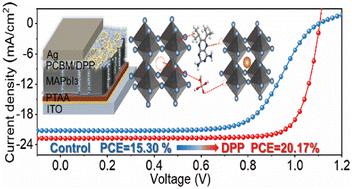当前位置:
X-MOL 学术
›
J. Mater. Chem. A
›
论文详情
Our official English website, www.x-mol.net, welcomes your feedback! (Note: you will need to create a separate account there.)
Simultaneous realization of bulk and interface regulation based on 2,4-diamino-6,7-diisopropylpteridine phosphate for efficient and stable inverted perovskite solar cells
Journal of Materials Chemistry A ( IF 10.7 ) Pub Date : 2023-12-14 , DOI: 10.1039/d3ta06808k Zhen He 1, 2 , Jian Xiong 1 , Yongsong Zhang 1 , Fu Liu 1 , Naihe Liu 1 , Junqian Dai 1 , Yongchao Liang 3 , Zheling Zhang 1 , Dongjie Wang 1 , Yu Huang 1 , Qiaogan Liao 1 , Jiang Wang 1, 2 , Jian Zhang 1
Journal of Materials Chemistry A ( IF 10.7 ) Pub Date : 2023-12-14 , DOI: 10.1039/d3ta06808k Zhen He 1, 2 , Jian Xiong 1 , Yongsong Zhang 1 , Fu Liu 1 , Naihe Liu 1 , Junqian Dai 1 , Yongchao Liang 3 , Zheling Zhang 1 , Dongjie Wang 1 , Yu Huang 1 , Qiaogan Liao 1 , Jiang Wang 1, 2 , Jian Zhang 1
Affiliation

|
Due to strict restrictions on the solubility and solvent choice, it is challenging to achieve an efficient solution-processed cathode interface material for inverted perovskite solar cells (PSCs). Herein, a simple and facile solution-processed interface strategy is proposed based on 2,4-diamino-6,7-diisopropylpteridine phosphate (DPP) to overcome bulk and interface recombination loss issues in inverted PSCs. The performances of the materials, interfaces, and the devices were systemically investigated. The results show that DPP exists at the fullerene/cathode interface and also diffuses throughout the whole perovskite/fullerene heterojunction, which results in the simultaneous realization of bulk and interface regulation. The interface energy mismatch between the (6,6)-phenyl-C61 butyric acid methyl ester (PCBM) and Ag interface, the defect-assisted recombination energy loss, and the residual stress of the perovskite film are all improved by DPP introduction. The power conversion efficiency (PCE) of the devices with DPP is enhanced by 33.49% compared to that of the control devices without DPP. The highest PCE of 20.17% and a hysteresis index of 1.80% were achieved with DPP, which is superior to that of the devices with a conventional bathocuproine (BCP) cathode interface layer. Owing to the DPP introduction, the thermal stability (85 °C in N2) is greatly enhanced and T80 (the time required for the PCE decay to 80% of its initial value) reaches up to 247 h, while T80 of the control devices is only 14 h. This work provides an extremely simple and unique strategy to simultaneously realize bulk and interface regulation with only one material for the construction of efficient and stable inverted PSCs.
中文翻译:

基于2,4-二氨基-6,7-二异丙基蝶啶磷酸盐同时实现体和界面调控高效稳定的倒置钙钛矿太阳能电池
由于溶解度和溶剂选择的严格限制,为倒置钙钛矿太阳能电池(PSC)获得高效的溶液加工阴极界面材料具有挑战性。在此,提出了一种基于2,4-二氨基-6,7-二异丙基蝶啶磷酸盐(DPP)的简单易用的溶液处理界面策略,以克服倒置PSC中的体积和界面重组损失问题。对材料、界面和器件的性能进行了系统研究。结果表明,DPP存在于富勒烯/阴极界面处,并且扩散到整个钙钛矿/富勒烯异质结,从而同时实现了体积和界面调节。DPP的引入改善了(6,6)-苯基-C 61丁酸甲酯(PCBM)与Ag界面之间的界面能量失配、缺陷辅助复合能量损失以及钙钛矿薄膜的残余应力。与不带DPP的控制器件相比,带DPP的器件的功率转换效率(PCE)提高了33.49%。DPP 的最高 PCE 为 20.17%,滞后指数为 1.80%,优于具有传统浴铜灵 (BCP) 阴极界面层的器件。由于DPP的引入,热稳定性(N 2中85℃ )大大增强,T 80(PCE衰减到其初始值的80%所需的时间)达到247小时,而T 80的控制装置仅需14 h。这项工作提供了一种极其简单且独特的策略,仅用一种材料即可同时实现体和界面调节,从而构建高效稳定的倒置 PSC。
更新日期:2023-12-14
中文翻译:

基于2,4-二氨基-6,7-二异丙基蝶啶磷酸盐同时实现体和界面调控高效稳定的倒置钙钛矿太阳能电池
由于溶解度和溶剂选择的严格限制,为倒置钙钛矿太阳能电池(PSC)获得高效的溶液加工阴极界面材料具有挑战性。在此,提出了一种基于2,4-二氨基-6,7-二异丙基蝶啶磷酸盐(DPP)的简单易用的溶液处理界面策略,以克服倒置PSC中的体积和界面重组损失问题。对材料、界面和器件的性能进行了系统研究。结果表明,DPP存在于富勒烯/阴极界面处,并且扩散到整个钙钛矿/富勒烯异质结,从而同时实现了体积和界面调节。DPP的引入改善了(6,6)-苯基-C 61丁酸甲酯(PCBM)与Ag界面之间的界面能量失配、缺陷辅助复合能量损失以及钙钛矿薄膜的残余应力。与不带DPP的控制器件相比,带DPP的器件的功率转换效率(PCE)提高了33.49%。DPP 的最高 PCE 为 20.17%,滞后指数为 1.80%,优于具有传统浴铜灵 (BCP) 阴极界面层的器件。由于DPP的引入,热稳定性(N 2中85℃ )大大增强,T 80(PCE衰减到其初始值的80%所需的时间)达到247小时,而T 80的控制装置仅需14 h。这项工作提供了一种极其简单且独特的策略,仅用一种材料即可同时实现体和界面调节,从而构建高效稳定的倒置 PSC。












































 京公网安备 11010802027423号
京公网安备 11010802027423号